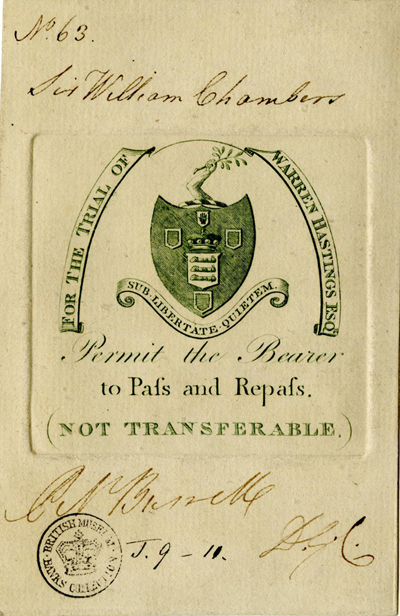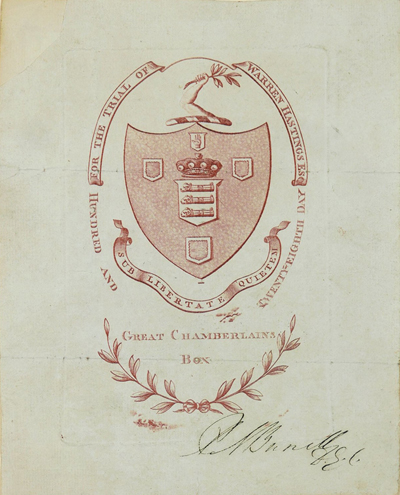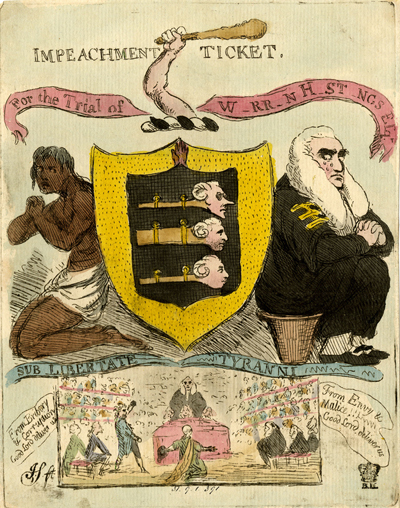Impeachment Ticket. . .
To understand Gillray's Impeachment Ticket, you must first realize that it is a parody of a parody, the third in a series images that begins with the actual ticket of admission to the much heralded impeachment trial of Warren Hastings, the former Governor General of Bengal on charges of corruption. The trial was held in Westminster Hall, beginning on February 13th 1788, and lasted for seven years.
The Admission Ticket
The admission ticket owes its basic form to the coat of arms of Bertie, Earls of Lindsay and Abingdon whose lands and titles were largely inherited by Peter Burrell, Deputy Great Chamberlain, through his wife, Lady Priscilla Bertie. Acccording to Wikipedia she succeeded to the barony of Willoughby de Eresby in 1780 and thus to the hereditary office of Lord Great Chamberlain, but as a woman, she could not serve. Her husband, however, was able to serve as her Deputy, thus presiding over the Hastings trial. As does the admission ticket, the Bertie/Burrell coat of arms featured a crown over a shield with three prominent battering rams.

© Trustees of the British Museum
The first tickets were small, numbered by hand, personally addressed and signed by Peter Burrell, and explicitly labeled "Not Transferable."
As demand for the tickets quickly skyrocketed, however, later tickets grew to approximately twice their size and more formal, containing the day they were good for (e.g. "Hundred and Twenty Eighth Day") and, in special cases, the specific location (e.g. "Great Chamberlain's Box") where the ticket bearer would sit.

© British Antique Dealers' Association
As in many family crests, above the shield there is an arm holding an object—in this case, an olive branch. And below the shield is a motto, "Sub Libertate Quietem," which can be loosely translated as "Peace under Liberty." The words are part of a quotation from the English politician and political theorist, Algernon Sydney: Manus haec inimica tyrannis Einse petit placidam cum libertate quietem. (This hand. enemy to tyrants, by the sword seeks calm peacefulness with liberty).
Sayers' Parody
Some time after the first week of the trial, James Sayers, Gillray's major competitor in graphic satire, created a parody of the admission ticket. It represented the point of view of the Crown which regarded the trial as a vicious assault upon Hastings, a miscarriage of Justice, and a violation of English Common Law.
![[Admission Ticket]](../images/lwl_impeachment-ticket-sayers.jpg)
[Admission Ticket]
[February, 1788]
© Lewis Walpole Library
It included the shield from the admission ticket with its three battering rams. But now the heads of the rams were replaced with portraits of three of the most prominent Whigs attacking Hastings. Those included (from top to bottom) Edmund Burke, Charles James Fox, and Philip Francis. It added, however, two heraldic "supporters"—the Law and Justice. The Law is represented by an advocate with cap labeled Common Law, weeping over a scroll in which "[Magna]Charta," "Judicium Parium," and "Lex Terrae" [the Magna Carta, equal i.e. fair judgment, and law of the land] have all been struck through.
Justice, in turn, is represented the familiar female figure with scales. But now she is shown dropping those scales and cowering in the face of the "almighty" arm of Parliament which no longer holds an olive branch of peace but a scourge with appended scorpions. The motto below the shield has changed from "sub libertate quietem" to sub libertate tyran[nis], suggesting that Parliament itself has become tyrannical.
At the bottom of Sayers' design, we get a glimpse into Westminster Hall where Charles James Fox is declaiming with upraised arm against Hastings. Beneath him is a book open to a passage from the Litany or General Supplication from the Book of Common Prayer—"From Envy, Hatred & Malice and all Uncharitableness Good Lord deliver us." suggesting that the attacks on Hastings were personally motivated, as in part they were. An unsuccessful duel with Hastings had been the last straw in a long-standing feud between Hastings and Francis, and the virtual starting point for Philip Francis's determined campaign against Hastings after Francis returned to England.
Gillray's Response
Gillray follows Sayers in many of the changes to the original admission ticket. Like Sayers, he changes the heads of the battering rams in the coat of arms to portraits of Burke, Fox, and Philips. But unlike Sayers he turns them around so that their battering seems to be directed at Chancellor Edward Thurlow. The chief judge is portrayed grim faced with tears in his eyes, but sitting on the chamber pot of a close stool. At roughly the same time, Gillray produced Blood on Thunder Fording the Red Sea (March 1st, 1788) which showed Thurlow wading through a red sea of Indian victims with Hastings on his back, so I suspect we are meant to interpret those tears as a show of false sympathy (excrement) while the poor native is pleading for justice beneath an upraised bludgeon.

© Trustees of the British Museum
Like Sayers, Gillray modifies the motto, but in this case the last word is not curtailed as it is in Sayers' print. It is explicitly "tyranni" which is to say, tyrants (plural). And although he includes the scene below the coat of arms with Fox declaiming against Hastings, Gillray adds Hastings kneeling before the assembly (as in fact he did while the charges were read) and a second text beside the image—"'From Bribery & Corruption Good Lord deliver us!"
As in many of his prints, Gillray assigns blame to both sides. He seems to follow Sayers in believing that Hastings may himself be a victim of "Envy & Malice", but he also believes that Hastings, Thurlow (and implicitly the Crown) have been guilty of "Bribery & Corruption."
Sources and Reading
- Commentary from the British Museum on James Sayers'Impeachment Ticket.
- Commentary from the British Museum on Gillray'sImpeachment Ticket.
- Nicholas K Robinson, Edmund Burke: A Life in Caricature, 1996, p. 101.
- "Warren Hastings," Wikipedia
- "Peter Burrell, 1st Baron Gwydyr," Wikipedia
- "Impeachment of Warren Hastings," Wikipedia
- "Edmund Burke," Wikipedia
- "Charles James Fox," Wikipedia
- "Philip Francis (politician)," Wikipedia
- "Earl of Lindsey," Wikipedia
Comments & Corrections
NOTE: Comments and/or corrections are always appreciated. To make that easier, I have included a form below that you can use. I promise never to share any of the info provided without your express permission.